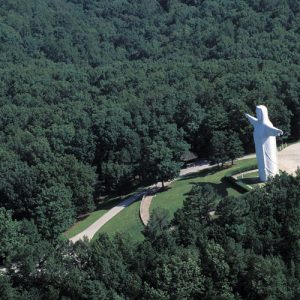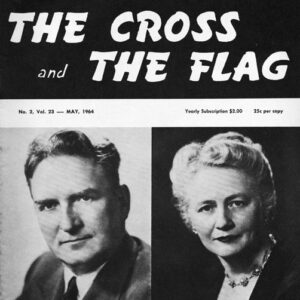calsfoundation@cals.org
Elna M. Smith Foundation
aka: Five Sacred Projects
aka: Sacred Projects
The Elna M. Smith Foundation was created in 1965 by Gerald L. K. Smith and his wife, Elna M. Smith, for whom it was named. The foundation is the nonprofit organization that serves as the umbrella company supervising the Five Sacred Projects and other activities and attractions on Magnetic Mountain, just east of Eureka Springs (Carroll County).
Gerald L. K. Smith was a controversial politician and anti-Semitic minister in the 1930s and 1940s. That controversy followed him to Eureka Springs. Even in retirement, he continued to write and publish segregationist and anti-Semitic tracts, including The Cross and Flag. However, he and his wife also began to commit more energies on creating a legacy of preserving Americana. Included in their dream was buying and restoring historic houses. That search brought them to Eureka Springs in 1964 to look at a Victorian house called Penn Castle, which they heard was for sale. They fell in love with the house, the city, and the area. Instead of buying the house for a summer home and museum for all their collections, they made it one of their permanent homes.
As new residents of Eureka Springs, the Smiths decided to invest in their adopted community. In 1965, Gerald Smith envisioned and proposed a giant statue of Jesus Christ overlooking the city and the surrounding area. In order to support and oversee the project, the Smiths formed the Elna M. Smith Foundation. The non-denominational ministry was funded by his friends and contacts—individuals and company representatives throughout the country.
The foundation bought 167 acres on top of Magnetic Mountain, directly east of Eureka Springs. Seven of the acres are within the city limits. Ground was broken for the Christ of the Ozarks statue on June 11, 1965. It was built quickly, and the seven-story-high statue was dedicated on June 25, 1966.
One day in 1966, while inspecting progress on the statue, Gerald Smith noticed that the nearby hillside formed a natural amphitheater. This led to the idea and construction of the foundation’s second major project, the Great Passion Play. The first performance, by invitation only, was on July 14, 1968, with the first public performance the next day. The 4,100-seat amphitheater has hosted more than 7.5 million people who have watched 200 cast members depict on a 500-foot-wide stage the last week in the life of Jesus Christ. It is the largest outdoor drama in the country. Smith’s controversial anti-Semitism and fascism were the basis of some of the criticism of the play.
The other Sacred Projects of the Elna M. Smith Foundation are the Bible Museum, the Sacred Arts Center, and the New Holy Land. Each of these was developed separately. The Bible Museum and the Sacred Arts Center were initially stocked with the private collections of both Smiths. As the museums’ holdings grew, both museums changed in several ways, including their locations. A round chapel, which was built originally as part of the New Holy Land, became a memorial chapel for Gerald Smith after his death in 1976. Today, the Bible Museum is located on the lower floor of the chapel. The memorial chapel became the Museum of Earth History, which opened in 2005 and promoted a young-Earth creationist point of view; it closed a few years later.
The Bible Museum houses one of the largest collections of Bibles in the world—more than 6,000 Bibles in 625 languages and dialects, as well as a large collection of parchments and artifacts. The Sacred Arts Center, originally called the Christ Only Art Gallery, has its own building. It opened in 1967 in downtown Eureka Springs. As its popularity grew, so did its holdings, which included many forms of biblical and religious art. The collection includes all forms of artistic design, including paintings, photographs, statues, figurines, jewelry, glassware, and pottery.
The New Holy Land originally was planned to be an elaborate, theme-park-type city of stone buildings representing the city of Jerusalem. Ground was broken in September 1971. A massive stone entrance to the city—a replica of the Eastern Gate to Jerusalem—and a round chapel were completed before plans changed. Instead of an entire stone city, it was decided to focus efforts on a tour of more than three dozen specific Holy Land sites, including a small Sea of Galilee, Christ’s tomb, Golgotha, a watchtower, a full-scale replica of Moses’s Tabernacle in the wilderness, the Ark of the Covenant, a water well, vineyards, dwelling units, and the Ten Commandments tablets. It has since been renamed the Living Bible Tour.
The Elna M. Smith Foundation, which is governed by an independent board of directors of twenty-three people, has evolved over the years, adding other projects and attractions to change with the times. The Little Chapel in the Woods, located close to the Passion Play grounds, sat in disrepair for several years and was scheduled to be torn down. The foundation stepped in and bought it and the land it sat on and established the Bible Museum in it. But when the museum was moved to its new location, the chapel was relocated to the Passion Play grounds and was completely remodeled and restored. It is now called the Church in the Grove and is a popular wedding site.
Other projects and attractions of the foundation include a large section of the Berlin Wall; the Top of the Mountain Dinner Theater, featuring gospel music; Parables of the Potter, a short dramatic demonstration of the ancient craft of pottery to impart biblical teachings; and an extensive Christian gift and apparel store. The foundation provided a Living Nativity during the Christmas season for many years and later renamed it “Beyond Dickens.”
For additional information:
Goh, Robbie B. H. “The Jerusalem of Jesus: Space and Pentecostal-Evangelical Branding in Orlando’s Holy Land Experience and Eureka Springs’ Holy Land Tour.” Culture and Religion 18.3 (2017): 296–323.
The Great Passion Play. http://www.greatpassionplay.com/ (accessed February 7, 2022).
Jeansonne, Glen. “Arkansas’s Minister of Hate: A Research Odyssey.” Arkansas Historical Quarterly 59 (Winter 2000): 429–435.
———. Gerald L. K. Smith: Minister of Hate. Baton Rouge: Louisiana State University Press, 1997.
Kovalcik, Timothy M. The Great Passion Play. Charleston, SC: Arcadia Publishing, 2008.
Dennis Schick
North Little Rock, Arkansas
 Divergent Prosperity and the Arc of Reform, 1968–2022
Divergent Prosperity and the Arc of Reform, 1968–2022 Recreation and Sports
Recreation and Sports Christ of the Ozarks
Christ of the Ozarks  The Cross and the Flag
The Cross and the Flag 




Comments
No comments on this entry yet.